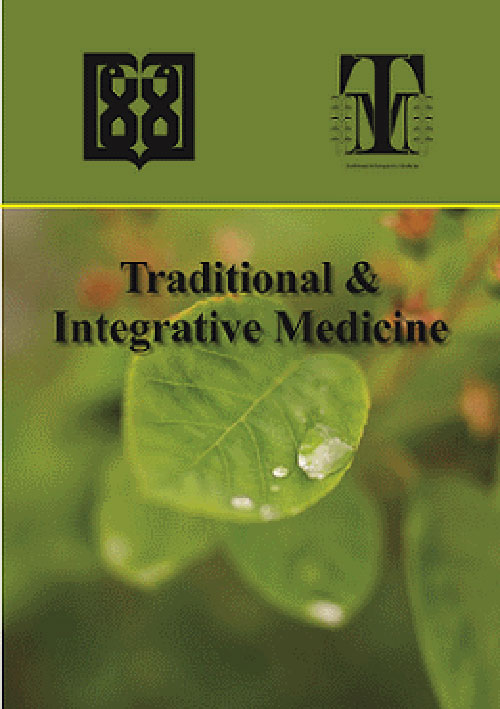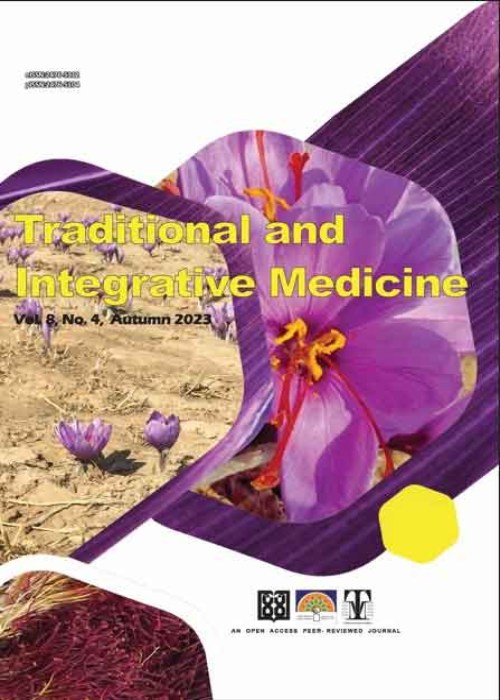فهرست مطالب

Traditional and Integrative Medicine
Volume:4 Issue: 4, Autumn 2019
- تاریخ انتشار: 1398/10/01
- تعداد عناوین: 7
-
Pages 165-169
Crisis is one of the sophisticated yet important and practical concepts of Persian medicine which have been discussed and pointed out throughout traditional medical literature starting from Hippocrates, Galen, Avicenna and others or discussed independently in their related treatises. Being so important, it was used to classify the days of illnesses according to days devoted to it (critical days) or the days forecasting it (warning days) and the days in between. Crisis was known to be an important change in the process of disease which afterwards the destiny of the patient was predicted. It was categorized by its completeness/incompleteness and its good/bad prognosis, timing and direction of the pathogenic substance displacement or excretion. Many factors have been known to affect the onset and type of crisis including type of illness, the temperament of the patient, the season of disease occurrence, and even the effect of heavenly bodies especially the tidal force of the moon and the sun. Therefore many branches of science like chronobiology, physics, nanomechanics, astrophysics and rheology are needed to understand and demystify the narrated information derived from centuries of clinical observation. This understanding may lead to the decoding of unknown causes of exacerbation and remission of chronic diseases like multiple sclerosis and so on. As mentioned in previous articles, we have also designed a set of treatments named SINA therapy to simulate good crisis artificially in order to hasten the coction period and facilitate the curing of the daily increasing material diseases.
Keywords: Avicenna, Crisis, Crises, Persian medicine, Safe inclusive nozj of alizadeh therapy (SINA therapy) -
Pages 170-175
The system of medieval medicine was based on the four humors (blood, yellow bile, black bile, and phlegm) theory that connected disorders to disturbance of humor balance. Herbal infusions containing fruits in a sugary solvent were one of the preferences when bile exceeded. Current study aimed to introduce the traditional nutraceutical of naqoa and analyze the formulations suited for bilious disorders. Formulations of naqoa were extracted from three main multi-component encyclopedias of Traditional Iranian pharmacy, Qarabadin Salehi, Qarabadin Kabir, and Qarabadin Azam. Fifteen compote-like formulations were selected and analyzed. The scientific names of ingredients were authenticated, and the constituents and pharmacology of highly-used ingredients were discussed. Frequent indications among 53 formulations of naqoa were fever, and bilious disorders such as hot-temperament headache, warmth in liver or stomach, and thirst. Highly-repeated ingredients in naqoa were fruits of Prunus domestica, Ziziphus jujube, Tamarindus indica, Prunus armeniaca, the flower of Viola odorata, and the manna of Alhagi maurorum. All things considered, the compote-like formulation of naqoa is a multi-fruit nutraceutical in a sugary solvent, that has been traditionally prescribed for bilious disorders as an efficient cholagogue.
Keywords: Nutraceutical, Naqoa, Cholagogue, Traditional iranian pharmacy -
Pages 176-180
Women’s diseases are types of the common problems that patients are seeking for treatment that imposes a lot of economic burdens on health systems. Many Persian medicine reference books mentioned various practical methods for the adjunctive treatment of the gynecological problems. In the Persian medicine resources, “Dalk” therapeutic method is the most appropriate word for massage. Many clinical studies have been conducted on applied massage in women's diseases which confirms the effects of “Dalk”in this regard. The purpose of this study is to investigate “Dalk”'s applications on women's diseases.
Keywords: Massage, Dalk, Persian medicine -
Pages 181-190
Headache is one of the most common public health problems in the world, which causes patients to see a doctor. Migraine is the second most common cause of headaches after tension headaches. This study is a randomized, double blinded, placebo - controlled clinical trial, using SF36 questionnaire, to evaluate the effect of combination of Viola odorata L., Rosa damascena Mill. and Coriandrum sativum L. on the quality of life, in patients with migraine after 4 weeks. In all domains of the SF36 questionnaire, the scores after intervention in the drug group were significantly higher than the control group after 4 weeks. This study showed that, combination of V. odorata, R. damascena and C. sativum, improves the quality of life of patients with migraine.
Keywords: Persian medicine, Viola, Migraine, Headache, SF36, Traditional iranian medicine, Complementary, alternative medicine (CAM), Quality of life -
Pages 191-199
Functional dyspepsia (FD) is a highly prevalent condition with high impact on healthcare costs. Considering the complimentary therapies options like phytotherapy, this study aimed to investigate the efficacy and safety of Nardostachys jatamansi (D.Don) DC. extract in sixteen FD patients. The subjects received capsules of 500 mg N. Jatamansi, 3 times daily before meals for 30 days. The severity of early satiation and postprandial fullness were assessed by self-report of improvement at least 50% of symptoms and other FD symptoms assessed by Gastrointestinal Symptom Rating Scale (GSRS) before intervention and at end of treatment. The mean GSRS score level decreased significantly after intervention among study population. Five patients had chief complaint of early satiety and post prandial fullness who all of them reported 50% improvement. According to the results N. jatamansi seems to be effective in patients with refractory FD. Randomized clinical studies seem to be required.
Keywords: Dyspepsia, Herbal medicine, N. jatamansi, Traditional medicine -
Pages 200-205
Rose oil (Rowghan-E-Gol) is valuable fixed oil from macerating or boiling Rosa damascena petals in olive or sesame oils. There is difference between the rose oil and rose essential oil. The aim of this study was to evaluate the therapeutic applications of rose oil in modern and traditional medicines. The information of this article was extracted from books (traditional and modern ones) and electronic resources. The results showed that there are four methods for extracting the rose oil, but macerating the fresh rose petals in sesame oil is resulted to higher quality oil. Traditionally, rose oil is used orally or topically in management of ailments with pain and inflammatory conditions such as hemorrhoid, inflammatory bowel disease (IBD), earache, gastro-esophageal reflux diseases. In modern medicine, there are two clinical trials (topical oil) and one case report study (oral oil), which confirmed the efficacy of rose oil in backache of pregnancy, migraine headache and gastritis. Therefore, evaluating the potential of rose oil in treatment of hemorrhoid, IBD and gastrointestinal tract diseases should be performed in large clinical studies.
Keywords: Rowghan-E-Gol, Rose oil, Migraine headache, Rosa damascena


